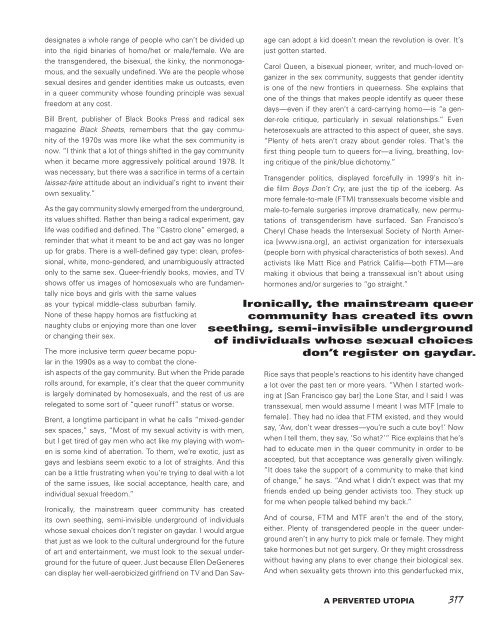Create successful ePaper yourself
Turn your PDF publications into a flip-book with our unique Google optimized e-Paper software.
designates a whole range of people who can’t be divided up<br />
into the rigid binaries of homo/het or male/female. We are<br />
the transgendered, the bisexual, the kinky, the nonmonogamous,<br />
and the sexually undefined. We are the people whose<br />
sexual desires and gender identities make us outcasts, even<br />
in a queer community whose founding principle was sexual<br />
freedom at any cost.<br />
Bill Brent, publisher of Black Books Press and radical sex<br />
magazine Black Sheets, remembers that the gay community<br />
of the 1970s was more like what the sex community is<br />
now. “I think that a lot of things shifted in the gay community<br />
when it became more aggressively political around 1978. It<br />
was necessary, but there was a sacrifice in terms of a certain<br />
laissez-faire attitude about an individual’s right to invent their<br />
own sexuality.”<br />
As the gay community slowly emerged from the underground,<br />
its values shifted. Rather than being a radical experiment, gay<br />
life was codified and defined. The “Castro clone” emerged, a<br />
reminder that what it meant to be and act gay was no longer<br />
up for grabs. There is a well-defined gay type: clean, professional,<br />
white, mono-gendered, and unambiguously attracted<br />
only to the same sex. Queer-friendly books, movies, and TV<br />
shows offer us images of homosexuals who are fundamentally<br />
nice boys and girls with the same values<br />
as your typical middle-class suburban family.<br />
None of these happy homos are fistfucking at<br />
naughty clubs or enjoying more than one lover<br />
or changing their sex.<br />
The more inclusive term queer became popular<br />
in the 1990s as a way to combat the cloneish<br />
aspects of the gay community. But when the Pride parade<br />
rolls around, for example, it’s clear that the queer community<br />
is largely dominated by homosexuals, and the rest of us are<br />
relegated to some sort of “queer runoff” status or worse.<br />
Brent, a longtime participant in what he calls “mixed-gender<br />
sex spaces,” says, “Most of my sexual activity is with men,<br />
but I get tired of gay men who act like my playing with women<br />
is some kind of aberration. To them, we’re exotic, just as<br />
gays and lesbians seem exotic to a lot of straights. And this<br />
can be a little frustrating when you’re trying to deal with a lot<br />
of the same issues, like social acceptance, health care, and<br />
individual sexual freedom.”<br />
Ironically, the mainstream queer community has created<br />
its own seething, semi-invisible underground of individuals<br />
whose sexual choices don’t register on gaydar. I would argue<br />
that just as we look to the cultural underground for the future<br />
of art and entertainment, we must look to the sexual underground<br />
for the future of queer. Just because Ellen DeGeneres<br />
can display her well-aerobicized girlfriend on TV and Dan Savage<br />
can adopt a kid doesn’t mean the revolution is over. It’s<br />
just gotten started.<br />
Carol Queen, a bisexual pioneer, writer, and much-loved organizer<br />
in the sex community, suggests that gender identity<br />
is one of the new frontiers in queerness. She explains that<br />
one of the things that makes people identify as queer these<br />
days—even if they aren’t a card-carrying homo—is “a gender-role<br />
critique, particularly in sexual relationships.” Even<br />
heterosexuals are attracted to this aspect of queer, she says.<br />
“Plenty of hets aren’t crazy about gender roles. That’s the<br />
first thing people turn to queers for—a living, breathing, loving<br />
critique of the pink/blue dichotomy.”<br />
Transgender politics, displayed forcefully in 1999’s hit indie<br />
film Boys Don’t Cry, are just the tip of the iceberg. As<br />
more female-to-male (FTM) transsexuals become visible and<br />
male-to-female surgeries improve dramatically, new permutations<br />
of transgenderism have surfaced. San Francisco’s<br />
Cheryl Chase heads the Intersexual Society of North America<br />
[www.isna.org], an activist organization for intersexuals<br />
(people born with physical characteristics of both sexes). And<br />
activists like Matt Rice and Patrick Califia—both FTM—are<br />
making it obvious that being a transsexual isn’t about using<br />
hormones and/or surgeries to “go straight.”<br />
Ironically, the mainstream queer<br />
community has created its own<br />
seething, semi-invisible underground<br />
of individuals whose sexual choices<br />
don’t register on gaydar.<br />
Rice says that people’s reactions to his identity have changed<br />
a lot over the past ten or more years. “When I started working<br />
at [San Francisco gay bar] the Lone Star, and I said I was<br />
transsexual, men would assume I meant I was MTF [male to<br />
female]. They had no idea that FTM existed, and they would<br />
say, ‘Aw, don’t wear dresses—you’re such a cute boy!’ Now<br />
when I tell them, they say, ‘So what?’” Rice explains that he’s<br />
had to educate men in the queer community in order to be<br />
accepted, but that acceptance was generally given willingly.<br />
“It does take the support of a community to make that kind<br />
of change,” he says. “And what I didn’t expect was that my<br />
friends ended up being gender activists too. They stuck up<br />
for me when people talked behind my back.”<br />
And of course, FTM and MTF aren’t the end of the story,<br />
either. Plenty of transgendered people in the queer underground<br />
aren’t in any hurry to pick male or female. They might<br />
take hormones but not get surgery. Or they might crossdress<br />
without having any plans to ever change their biological sex.<br />
And when sexuality gets thrown into this genderfucked mix,<br />
A PERVERTED UTOPIA 317


